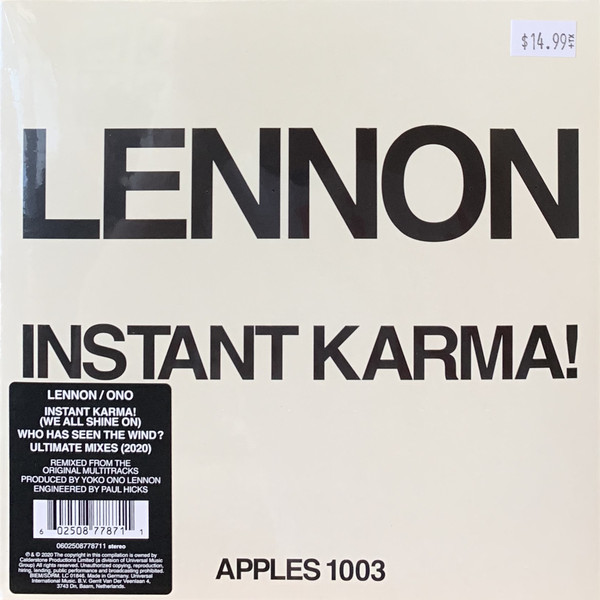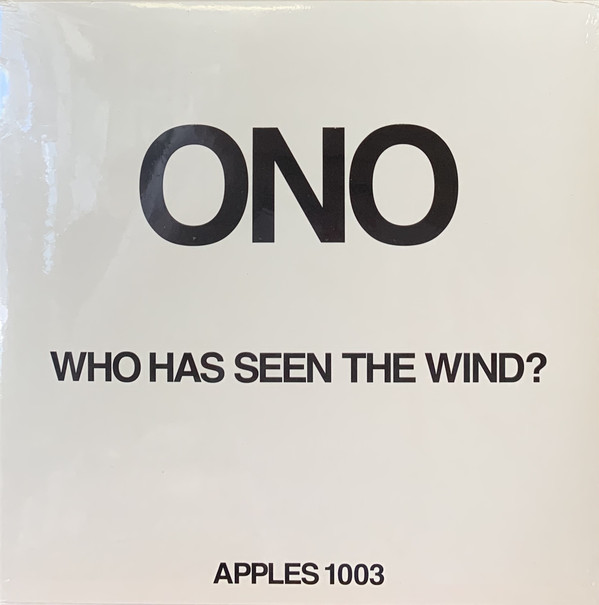Yoko Ono, born 18 February 1933 in Tokyo, Japan, is an experimental musician whose work stretches back more than half a century. Working with art group Fluxus throughout the 1960s, Ono was a pioneer in the burgeoning conceptual art movement which included work in sculpture, performance, filmmaking and music.
Few women in the history of rock & roll have stirred as much controversy as Yoko Ono. Although her romance with Lennon was hardly the only factor straining the relationships between the Beatles, she became a convenient scapegoat for the group's breakup and was repeatedly raked over the coals in the media for her influence over Lennon, both in his life and his music. Ono's own work as an artist and musician didn't mitigate the public's enmity toward her; to the average man on the street, her avant-garde conceptual art seemed bizarre and ridiculous, and her highly experimental rock & roll (which often spotlighted her primal vocals) was simply too abrasive to tolerate. That view wasn't necessarily universal, and in fact the merits of her work are still hotly debated.
Regardless of individual opinion, Ono has left a lasting legacy; she was an undeniably seminal figure in the history of performance art, and elements of her music prefigured the arty sides of punk and new wave (whether she was a direct influence is still debated, although The B-52's did admit to drawing from her early records). Moreover, between Lennon's assassination and the myriad drubbings she's taken in the press and public opinion, an alternate portrait of Ono as a strong, uncompromising survivor has emerged in more recent years.
Yoko was born into a wealthy family in Tokyo. Her childhood was somewhat lonely and isolated; her father, a banker and onetime classical pianist, was transferred to San Francisco a few weeks before she was born, and her socialite mother was often busy throwing elaborate parties. Yoko didn't meet her father until age two, when the whole family moved to San Francisco. However, they returned to Tokyo three years later to avoid the anti-Japanese backlash that was beginning in the United States in response to Japan's growing military expansionism. Ono was educated at the Gakushuin School, the most exclusive private school in Japan (the Emperor's sons were her classmates). She began classical piano lessons at a very young age, and later received vocal training in opera. In 1945, her mother took the family to the countryside in time to survive the massive Allied bombing of Tokyo. However, rich city dwellers were unwelcome, and the Ono children were often forced to beg for food.
After the war, Ono's father transferred to New York, and she moved to the U.S. in 1952, where she studied music at Sarah Lawrence College. During this time, she became enamored of classical avant-gardists like Schoenberg, Webern and especially Cage. She also began dating Juilliard student Toshi Ichiyanagi, who shared her interests and became her husband (over her family's objections) in 1956. The couple moved to Manhattan, and Ono made ends meet by teaching Japanese art and music in the public school system, among other sporadic jobs (she'd rejected her parents' wealth and the attendant lifestyle). The couple's Chambers Street loft soon became a hot spot in the nascent downtown art scene; Ono frequently staged "happenings" (sometimes in partnership with minimalist composer LaMonte Young) that featured music, poetry and other performance, and John Cage used the loft space to teach classes in experimental composition. During this period, Ono's art was largely conceptual, sometimes existing only in theory or imagination; she created a series of instructional pieces suggesting nonsensical activities, later published in book form as Grapefruit in 1964. Her first solo show was at George Maciunas' gallery in mid-1961; the same year, Ichiyanagi and Ono separated, with the former returning to Japan.
That November, Ono performed at the Carnegie Recital Hall (not the main hall), an event that featured a miked-up toilet flushing at various points throughout the show. It received negative reviews, however. With her parents' encouragement, Ono returned to Japan in March 1962, seeking a resolution to her marriage.
Once in Japan, Ono became lonely and depressed; not only was her marriage effectively over, but she received more negative reviews for her performances in conjunction with Cage. After an overdose of pills, she was committed to a mental institution and kept under extremely heavy sedation. Fortunately, she was rescued by Anthony Cox, a jazz musician, film producer and friend of Young who had traveled to Japan hoping to study calligraphy with her. Cox threatened to publicize the callous treatment Ono had received at the institution (her sedative dosage was abnormally high) and secured her release; the two became romantically involved, and when Ono became pregnant, she made her divorce from Ichiyanagi official and married Cox. Their daughter Kyoko was born in 1963, but Cox's sometime volatility put a strain on the relationship, and they separated in 1964. Cox returned to New York, and Ono followed a few months later, after which the couple reconciled.
Ono resumed her art career to considerable attention from the New York avant-garde community; by this time, George Maciunas had become the leader of an art movement dubbed Fluxus, whose philosophies were compatible with (and even influenced by) Ono's, prizing abstraction and audience interaction. Ono performed at the Carnegie Recital Hall for a second time in early 1965, and debuted her seminal "Cut Piece," in which audience members were invited to cut off pieces of her clothing with scissors. In September 1966, she traveled to England for an art symposium, and "Cut Piece" helped make her a sensation in the London art world. In November, she got her own exhibition at the famed Indica Gallery, which was ardently patronized by John Lennon. Lennon was impressed by her work, particularly a piece where the viewer was required to climb a ladder and hold up a magnifying glass to read a small inscription on the ceiling that said "Yes!" The two read each other's writings, and Lennon financed an exhibition in which Ono painted various everyday objects white and cut them in half. In the meantime, Ono and Cox had begun making experimental films, usually centered on the repetition of simple movements; their fourth effort, Bottoms, consisted of 365 close-ups of nude buttocks (the idea was to fill the screen with motion when the subjects walked). British film censors were scandalized, and Ono became an even more notorious public figure with "Wrapping Event," in which she wrapped the lion statues beneath Nelson's column in Trafalgar Square with white cloth and tied herself to one. She also sang in concert with pioneering free jazz saxophonist Ornette Coleman at the Royal Albert Hall. The avant-garde was becoming increasingly suspicious of her visibility, which only intensified when Ono and Lennon began having an affair that spring.
Fans of Lennon couldn't understand what he saw in Ono, but Lennon was an art student prior to falling in love with rock & roll and had long harbored an interest in avant-garde art. The difficulty with understanding Ono's art was that its impact came largely from her ideas; from putting new contextual frames around everyday objects, or asking her audience to complete an experience with their own imaginations. For example, most of Ono's pieces were white, so that the audience could imagine their own colors; even her so-called "Blue Room" was all-white (viewers were supposed to stay in the room until it turned blue). Her first musical composition, 1955's "Secret Piece," existed only in her mind (she was unable to transcribe the notes of a bird song effectively), and, in 1968, she announced a 13-day dance festival that would take place entirely in the imaginations of anyone who participated. In 1971, she took things a step further by presenting an imaginary art exhibit at New York's Museum of Modern Art, and filmed the spectators as the real works of art. As an artist, Ono dealt in concepts, not craft (i.e., practiced, developed technique and training in a specific medium). Her work wasn't what most people recognized as art, which was why many Beatles fans dismissed her as a talentless charlatan. Lennon, on the other hand, saw someone who could help him find a new direction.
Lennon and Ono's first musical collaboration was on the highly experimental Unfinished Music, No. 1: Two Virgins, which was recorded around the beginning of their affair and released toward the end of 1968. None of Lennon's fans knew what to make of any aspect of the album; not the odd snippets of noise, faint dialogue and sounds from the immediate environment, and not the fully nude photographs of the couple on the record jacket, taken from the front and rear. They were further dismayed with Lennon's participation in Ono's bizarre public events, such as appearing together in black plastic bags as a statement about judging by appearances. (Ono herself long suspected that fans' hostility was due to their discomfort seeing Lennon with a woman who was not only strong-willed, but of a different race.) After Ono's divorce from Cox, the couple married in Gibraltar on March 20, 1969, and took advantage of the publicity surrounding their honeymoon to hold "Bed-Ins for Peace" in Amsterdam and Montreal (the latter of which produced the single "Give Peace a Chance"). Cox was later able to gain custody of Kyoko, pointing to Lennon and Ono's drug intake, and disappeared with the child, whom Ono would not see again for 25 years.
The second Lennon/Ono album, Unfinished Music, No. 2: Life with the Lions, was released not long after their wedding; it spotlighted Ono's cathartic, wailing vocal improvisations, as well as addressing her first of several miscarriages. It was quickly followed by The Wedding Album, one side of which featured more Ono improv, the other of which consisted of nothing but the couple calling each other's names. Over the next few years, Lennon and Ono continued their peace activism and entered primal-scream therapy with Dr. Arthur Janov, which began to inform both of their individual careers. In 1970, they each recorded an album backed by the Plastic Ono Band; predictably, Yoko Ono/Plastic Ono Band was the less structured, more avant-garde of the two. Ono followed it in 1971 with the double-LP Fly, which featured more conventionally structured songs as well as her typical experimentalism. In 1972 the Lennon/Ono protest-song album Sometime in New York City was released, and was roasted for the simplicity of its sentiments.
Ono returned in 1973 with two of her strongest solo statements, the brutally intense, explicitly feminist Feeling the Space and the more varied Approximately Infinite Universe, both of which featured less musical involvement from Lennon. Perhaps that was symptomatic of the problems the couple had been having; they split up for a year and a half toward the end of 1973, exhausted from their constant time together and their battles with U.S. immigration over Lennon's threatened deportation. Ono recorded a more accessible album, A Story, in 1974, but it was shelved and remained unavailable until 1997.
The couple got back together in early 1975, and Ono was finally able to bear a child, Sean Taro Ono Lennon, who was born on John's birthday, October 9. Lennon dropped out of show business for several years to raise his son and effectively become a househusband, while Ono took charge of his business affairs. Although she contributed some of her most accessible songs to his 1980 comeback album, Double Fantasy, she did not return to solo recording until after Lennon's assassination on December 8, 1980. The harrowing, grief-stricken Season of Glass was released the following year to highly complimentary reviews. Ono followed it in 1982 with the more hopeful, pop-oriented It's Alright (I See Rainbows), and had a minor success with the single "Never Say Goodbye." Released in 1985, Starpeace continued that optimistic trend, and teamed Ono with producer Bill Laswell and other downtown New York scenesters, but failed to connect as her previous two efforts had.
Ono gradually returned to visual art, creating installations and also exploring photography. Interest in her previous work led to several retrospectives over the course of the '90s, and in 1992 Rykodisc reissued her complete back catalog on CD, as well as the six-CD box set retrospective Onobox. In 1995, she recorded a new album for Capitol called Rising, which featured son Sean Lennon and recalled the harsh experimentalism of her early recordings. The same year, her musical play New York Rock debuted off-Broadway. In 2001 another new album, Blueprint for a Sunrise, arrived, updating the feminist tone of Feeling the Space while being somewhat more accessible. V2 reissued several of her albums once again in early 2007. Also during this year, she issued Yes, I'm a Witch. For this album, she assembled a number of previously released tracks and collaborated with artists such as Cat Power, The Flaming Lips, DJ Spooky, Jason Pierce, and many others. In 2009, Ono re-formed the Plastic Ono Band with Sean and added collaborators such as Yuka Honda from Cibo Matto and members of Cornelius; she released the album Between My Head and the Sky on Sean's Chimera imprint.
For Your Information :
Yoko Ono was married to Toshi Ichiyanagi (一柳慧) from 1956 to 1963.
Read more on Last.fm. User-contributed text is available under the Creative Commons By-SA License; additional terms may apply.



